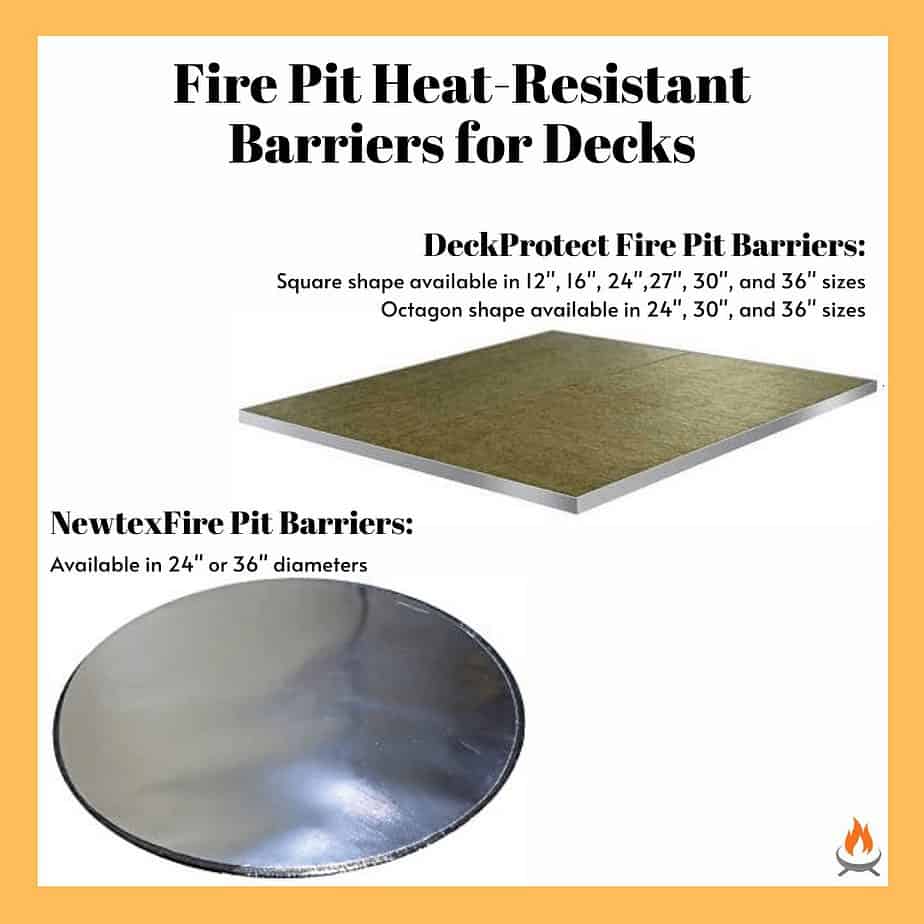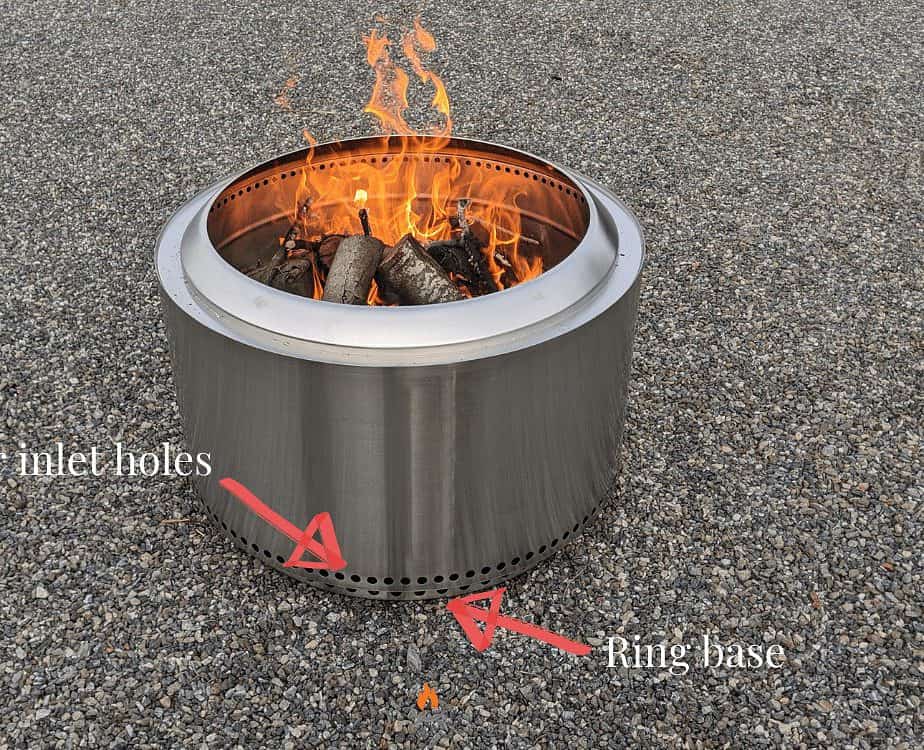Deck fire pits are now a luxury most can experience without spending thousands on intrusive modifications to your current deck infrastructure. It is important to know the dimensions of your deck before purchasing a fire pit, but once you make your purchase, installation is as easy as setting up any other piece of outdoor furniture.
The wrong fire pit, though, and the lack of a proper fire pit heat shield will cause heat-related cosmetic and structural damage, the effects of which can be immediate with others developing over time.
Safety should always be in your mind, but the potential costs of repairing heat-related deck damage are hard to ignore.
As we move on, I’ll cover my picks for the best fire pits for decks and several tips and other considerations when deciding which way to go. Let’s dive in!
The bottom line up front, gas-burning fire pits are ideal for deck use due to their design and the lower heat generated than wood-burning fire pits.
With that said, if you are partial to using firewood as a fuel source, there are several portable wood-burning fire pits designed to make them a desirable option on various surfaces.
At all times, gas and wood-burning deck fire pits should be positioned on top of some heat-resistant barrier designed to protect the wood and composite surfaces.
What Features Make a Specific Deck Fire Pit a Good Choice?
To be a good option for deck use, a fire pit must have certain features that, by design, reduce the amount of heat that radiates downward toward the deck surface.
Fire Pit Distance from Deck
Some wood-burning fire pits generate temperatures exceeding 1,000 degrees F, so keeping that heat source as far away from your deck’s surface as possible will reduce the risk of damage.
A good deck fire pit should possess an adequate stand-off or clearance distance between the primary heat source and the wood or composite deck surface on which the fire pit is sitting.
The typical portable gas fire pit will have approximately a 4-6 inch clearance, with the heat source anywhere from 4-6 above that, which is more than adequate. More on why later.
For your standard wood-burning fire pit bowl, recommend a clearance of at least 8 inches between the heat source and the deck surface.
This minimum distance allows for greater downward radiant heat dissipation and a more tip-resistant, low-center-of-gravity support design.
Some wood-burning designs don’t maintain this distance, but with the right heat-resistant barrier, they are still good options.
Solid heat-resistant fire pit barriers for use on decks include options like the DeckProtect models (see my review here) and those by Newtex (see below) – both are available on Amazon.

If you opt for a wood-burning backyard fire pit, I recommend the DeckProtect barriers; they’re more suited to the higher temps, potential sparking, and hot debris that comes with using a fire pit fueled with firewood.
The Newtex fire pit barriers aren’t as robust as the DeckProtect models but are well suited for propane fire pits that don’t throw off as much heat (especially downward) and don’t spark or have hot embers that might leave the confines of the fire pit.
These barriers have a shallow profile, and their low price makes them an attractive option for gas fire pit users looking for a bit of extra protection for their deck.
How the Fire Pit Heat is Directed
This qualifier makes a gas fire pit the better option for deck use.
Gas fire pits, by design, typically channel their heat source, the flame, upwards or to the side.
This results in the bulk of the heat exiting vertically and/or distributed evenly to lava rock or glass if used, not downward. So, the risk of heat damage to your deck is lessened.
On the wood-burning fire pit side, heat is naturally vectored upward, but it’s much greater intensity than in a gas-burning fire pit.
This difference in heat intensity makes a wood-burning fire pit a slightly less-desirable option for deck use.
While most of the heat generated during wood combustion will escape through the mouth of the fire pit, much will radiate downward, heating the lower portion of the fire pit’s walls, bowl, and support structure (legs, pedestal, etc.).
This is the heat that will damage your deck over time.
Does the Fire Pit Emit Anything That Might Damage a Deck?
Another consideration, in addition to the potential of radiant heat damage from the fire pit, is whether or not anything harmful can be ejected during use that might cause scorching, pitting or other damage to the surface.
Gas fire pits seldom emit material that might be harmful to your deck. Selecting the right rocks, though, should you choose to use certain types of rocks, is critical.
Some rock types, ones that are water and air permeable, can rupture under the high-heat conditions of a gas fire pit.
Stick to fire pit rock specifically marked for fire pit or grill use.
Wood-burning fire pits, depending on the type and quality of the firewood you are using, can have popping and sparking and the potential for hot embers leaving the fire pit during firewood shifting.
This hot material leaving the fire pit can, at a minimum, cause cosmetic deck damage, which should be considered when choosing what type of fire pit to use on your deck.
My Choices for the Best Deck-Safe Fire Pits
First, after reading this far, I don’t want anyone to think this site is an anti-wood-burning fire pit.
In most cases, my bias is toward the wood-burning type.
My opinion of gas-burning propane fire pits in this article is purely practical, with the protection of decks as the priority.
With that out of the way, my recommendations will include two gas and two wood-burning fire pit options, with one of those as the “Best Overall.”
I’ll also talk a bit about what you’ll need to do to make your choice work for you and your deck.
Best Gas Fire Pits for Decks
Option #1: Outland Firebowl 863 (click to see it on Amazon)
Outland fire pits are probably among the market’s most low-maintenance portable propane fire pit options.
They’re pretty popular with the RV set and campers who don’t like to completely “rough it.”
Like the rest of their line, the 863, or the Cypress, as Outland also calls it, is lightweight and generally pretty durable, with most of the metal being powder coated with some components fabricated in stainless steel.
In my experience, I’ve never heard anyone complain about Outlands rusting, but I’d still pack it away out of the weather each time after it cools.
Rust always seems to find a way to make an appearance, particularly around the metal that gets hot regularly.
Speaking of rust, check out my article on battling fire pit rust.
Anyway, like the rest of their line, the Cypress rings in at 58,000 BTUs heat-wise, connected to a 20 lb (5 gal.) propane tank, which conveniently is also a size commonly used with barbecue grills. Depending on how high you set the flame, you can get about 24 hours of burn time from a single tank.
Note, it does not come with the required 20 lb propane tank, so you’ll have to either buy one and get it refilled or get one through a tank exchange system like Blue Rhino.
What Makes the Outland 863 a Good Fire Pit for Deck Use: The propane burner for this fire pit orients the unit’s flame on a roughly 45-degree angle up and toward the interior and exterior of the fire pit, keeping heat directed away from the bottom of the unit.
Check out Outland Living’s promo video of the Cypress being used on a pier with wood decking.
Video Credit: Outland Living
The unit is supported by a system of four legs (always a good sign; four is always better than three) connected by a stabilizing metal ring that is the single point of contact with the deck surface. That round metal ring will keep this fire pit from tipping for whatever reason.
Also, the fire pit “bowl” is approximately 5-6 inches off the deck, allowing good airflow and heat dissipation.
What I Like: Ease of use; lightweight; little in the way of cleanup; not having to worry about safety issues related to wood continuing to burn after the party is over; relatively low downward heat emission to damage decks or balconies (link to my article on balcony fire pit use).
What I Don’t Like: The presence of a hose that someone could trip over; not much can be done about that other than making sure everyone steers clear of it.
Option #2: Tacklife Propane Fire Pit Table (link to Tacklife)
The Tacklife fire pit table is a decent choice for those who want a stationary option on their deck.
The Tacklife looks better than the Outland 863, and it’s more suited to pair with your current deck furniture. When not in use, this model can transition into a functional table space when the burner is covered with the square lid that is included with the unit.
This propane fire pit table is in the entry-level fire pit category at its current price point. With that said, they are surprisingly well-built, weighing in at a little over 50 lbs.
The fire pit outer housing and table surface are steel with the burner unit and control panel made from stainless steel.
The company claims to use a proprietary rust-proofing paint process on the outer surfaces and complaints are few about the Tacklife rusting so that’s a plus.
As with most things like this though, I would not leave it outdoors in the elements uncovered for too long. You’ll risk fading to the surface coating and as the unit ages and rust will most likely come.
The burner unit is rated at 50,000 BTUs, which is not as high as the Outland 863, but the difference is not particularly noticeable.
Like the Outland 863, the Tacklife does not come with the required 20 lb. propane tank.
What Makes This a Good Fire Pit for Deck Use: When assembled, the burner element is about 2 feet from the deck surface. That amount of stand-off between the heat source and the deck is more than sufficient to minimize the risk of damaging your deck.
The unit at its base is perfectly square, with four short (~2″) legs holding it off the deck. This design allows for adequate airflow under the unit and spreads the load around, minimizing the potential of an inadvertent tip-over.
Also, the weight from the propane tank inside, particularly when full, should aid in keeping the unit steady by lowering its center of gravity
What I Like: Performance and looks are solid for the price. If you are new to gas fire pits, this is a good entry point and a stepping stone to nicer, more expensive patio models in the future.
What I Don’t Like: A common complaint with this fire pit table is that it is a pain to put together and I can relate to an extent.
If you’re pretty handy around the house and have a solid set of basic tools it shouldn’t be any problem. If not, it might take a little longer to get it up and running.
With a lot of items at this price point, the hardware you get with them is not always the best, and by hardware, I’m talking about the screws, washers, etc.
Take your time and use the right size tool for the job to avoid stripping.
Best Wood-Burning Fire Pit for Decks
Option #3: Solo Stove Bonfire (link to Solo Stove )
The
What makes Solo Stoves in general an attractive option for a deck is the fact that they are designed to be smokeless and do that job pretty well.
You may get some smoke when adding new wood but generally, the level of smoke is low to non-existent once the fire gets going.
This is a nice feature, especially if you have a small deck that’s right up against the house or close to neighbors.
The
I’ve got the original 30″
I can tell you, once a fire is raging, the exterior is going to naturally be uncomfortably hot to the touch, but that area down by the inlet holes isn’t a problem. It’s going to be relatively cool to the touch.
That said, I think you should always be wary when using a wood-burning fire pit of any type on a wood or composite deck. Because of the

To ease fears of using a
These bases provide a stand-off between the fire pit and the surface the fire pit is sitting on (your wood or composite deck for example) as well as providing airflow underneath.
Even with its platform, I would recommend a heat-resistant barrier of some type, under the
Solo Stove claims you can use it directly on a deck in its promotional material along with a video showing it (see below).
Regarding the use of a heat barrier on your deck with the
If paving stones aren’t your thing, there are a variety of commercially available deck/grass fire pit barriers available.
Check out my article on safely using fire pits on decks for more (insert fire pit on deck article).
What Makes This Fire Pit Safe for a Deck: As I mentioned before, this fire pit is designed to be smokeless which is something you want if your fire pit is set up on your deck and close to the house, windows, sliding door, etc.
Also, as this fire pit is cylindrical, so by design it’s stable and resistant to tipping.
The high walls of this fire pit also do a good job keeping the fire pit’s contents in the fire pit and not on your deck causing damage.
Finally, the
What I Like: It just looks really good out of the box (sorry), stays lit, burns even low-quality wood/kindling well, has low to no smoke, and not much left to dispose of after the fire is out – just powdery ash.
What I Don’t Like: Solo Stove fire pits do sometimes have issues with rust. If the
You will see it develop a nice purplish and/or gold patina over time, but that’s to be expected of any metal that is regularly exposed to high-heat conditions. I don’t see that as a downside though.
For more, see my review of the Solo Stove Bonfire smokeless fire pit.
Conclusion: Best Fire Pit Safe for Deck Use Overall
Option 1: The Outland Firebowl 863 Cypress (link to Amazon)
First, all three fire pit options are solid – I wouldn’t have featured them if they weren’t. But…
Like the other two options, the Outland Firebowl 863 Cypress does a great job keeping the heat source up and off the deck and is designed as a stable tip-resistant platform.
These are the primary features we were looking for in protecting people and decks.
The 5 features below broke the tie for our selection:
- Ease of set up and lighting
- Highest BTUs of the gas options
- Not too big/not too small; well suited for use on decks of all sizes and can easily be moved/put away if space is at a premium
- Easy transport, set up, and use in locations other than your deck
- Excellent value for the price/most affordable of the three
For more on using fire pits on decks, check out my article, the Ultimate Guide to Using a Fire Pit On Decking.
Thanks for reading!
John
